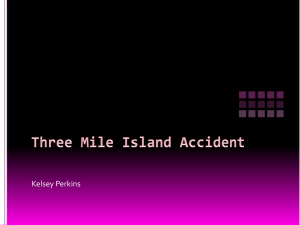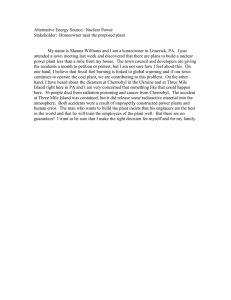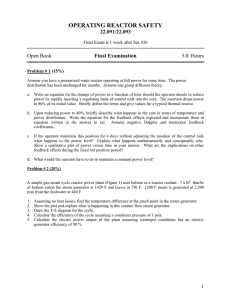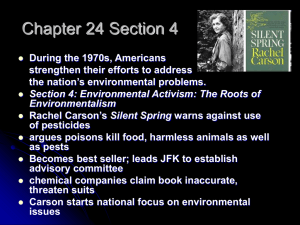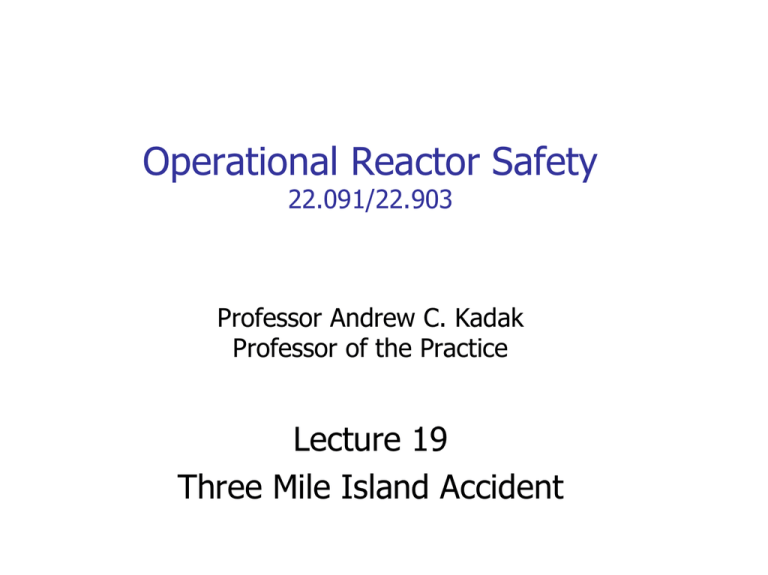
Operational Reactor Safety
22.091/22.903
Professor Andrew C. Kadak
Professor of the Practice
Lecture 19
Three Mile Island Accident
Primary system
Pilot operated relief valve
Secondary System
Emergency Cooling Pump
Feedwater line
Pressurizer
Figures © Hemisphere. All rights reserved. This content is excluded from our Creative Commons license.
For more information, see http://ocw.mit.edu/fairuse.
3
Figures © Hemisphere. All rights reserved. This content is excluded from our Creative Commons license.
For more information, see http://ocw.mit.edu/fairuse.
4
Davis Besse Event:
September 24, 1977 - 9:24 PM
Power Level 9%
Transient initiated - Loss of “feedwater” to steam
generator
Temperature increased in reactor
Water level in pressurizer increased
Pilot Operated Relief Valve (PORV) opened
PORV did not close but stuck open
Reactor Automatically Shutdown
Emergency Feedwater pumps automatically started
Primary coolant system cooled and shrunk
5
Primary system
Pilot operated relief valve
Secondary System
Emergency Cooling Pump
Feedwater line
Pressurizer
Figures © Hemisphere. All rights reserved. This content is excluded from our Creative Commons license.
For more information, see http://ocw.mit.edu/fairuse..
6
Event Sequence Continued
Primary circuit pressure dropped rapidly
Coolant leakage out of PORV
Coolant shrinkage (cooldown)
Emergency Core Cooling System (ECCS)
automatically starts to provide more water
Operators monitoring water level in pressurizer which
was changing until with ECCS water level became
normal.
Operators shutdown ECCS cooling water system
However PORV still open - “small break loss of
coolant accident”
7
Event Sequence Continued
Since PORV was open - pressure kept dropping
reaching “saturation pressure” of coolant which
allowed the water to boil - forming steam voids which
caused the pressurizer water level to rise.
22 Minutes later, operators determined that there
was a continuing primary coolant leak and closed the
block valve downstream of the pressurizer.
Operators then restored cooling water by ECCS and
water make up system of reactor and returned
reactor to normal shutdown condition.
8
Consequences
Core damage accident avoided by timely operator
action.
NRC, Babcock and Wilcox and the utility investigated
the incident
Neither NRC nor the nuclear steam supplier - B&W
shared this information with other B&W plants or the
rest of the industry.
1975 Rasmussen (MIT Prof) Report analyzed
probabilistic risks (PRA) of nuclear plants
Conclusion - small break LOCAs are dominant accident
contributors
NRC and critics did not want to use PRA is safety
determinations
9
18 MONTHS LATER
March 28, 1979
Courtesy of Three Mile Island Nuclear Power Station. Used with permission.
10
Three Mile Island
What Happened and Why ?
Courtesy of Three Mile Island Nuclear Power Station. Used with permission.
11
What Is Three Mile Island ?
TMI is a two unit nuclear plant site in Middletown,
Pennsylvania
Unit 1- 792 Mwe: Unit 2 - 880 Mwe
Babcock & Wilcox Designed PWR
2 Steam Generators - once through
4 Main Coolant Pumps
Condensers cooled by Cooling Towers
12
Primary system
Pilot operated relief valve
Secondary System
Emergency Cooling Pump
Feedwater line
Pressurizer
Figures © Hemisphere. All rights reserved. This content is excluded from our Creative Commons license.
For more information, see http://ocw.mit.edu/fairuse.
13
Steam Generators
B&W Once Through Steam Generator
Recirculating U Tube Steam Generator
Courtesy of Three Mile Island Nuclear Power Station. Used with permission.
14
Reactor Shutdown Signals
Overpower
High Temperature Outlet
High Pressure
Reactor Building Pressure
Low Pressure
Power imbalance/flow
Reactor Coolant Pumps
ARTS - anticipatory reactor trip system
(not at TMI) - for feedwater and turbine trip for Integrated Control
System)
15
Precursors
TMI Unit 2 - Newest Unit on Site
Small coolant leak in the pressurizer relief valve
raises temperature downstream of valve which drains
into the drain tank
Operators unaware that two valves on emergency
feedwater valves were closed following maintenance
(were supposed to be open).
Small blockage in a transfer line for demineralizer
resins which could not be cleared.
16
Initiation
Plant operating normally at 97% power
4:00:37 (AM) loss of condensate flow due to a
condensate pump trip (shutdown).
17
Key Sequence of Events
Courtesy of Three Mile Island Nuclear Power Station. Used with permission.
18
Courtesy of Three Mile Island Nuclear Power Station. Used with permission.
19
Courtesy of Three Mile Island Nuclear Power Station. Used with permission.
20
Courtesy of Three Mile Island Nuclear Power Station. Used with permission.
21
Courtesy of Three Mile Island Nuclear Power Station. Used with permission.
22
Courtesy of Three Mile Island Nuclear Power Station. Used with permission.
23
Bubble Trouble
Hydrogen Production
Oxygen generation due to
Radiolysis
Boiling
Possible explosive mixture ?
Due to zirconium water reaction
Why or why not ?
Why missed in analysis ?
Was reactor vessel in danger of exploding ?
What was missing in the approach ?
NRC - Industry
Courtesy of Three Mile Island Nuclear Power Station. Used with permission.
24
Figures © Hemisphere. All rights reserved. This content is excluded from our Creative Commons license.
For more information, see http://ocw.mit.edu/fairuse.
25
Inside TMI Reactor Vessel Post Accident
Courtesy of Three Mile Island Nuclear Power Station. Used with permission.
26
1979
Today
Courtesy of Three Mile Island Nuclear Power Station. Used with permission.
27
Public Health and Environmental
Consequences
Studies by EPA, Health and Human Services, DOE, NRC
and the State of Pennsylvania
Thousands of environmental samples
Conclusions
Average dose to 2 million people in area < 1 mrem
Max dose at site boundary full time - 100 mrem
Natural background in area - 100-125 mrem/yr
1 Chest x-ray - 6 millirem
No adverse Health Effects
28
Lessons Learned (Good)
Water helps even if core is severely damaged
Vessel did not fail even with molten core in the bottom
No energetic steam explosion
Most fission products contained inside
Containments work
29
Lessons Learned (not so good)
Inadequate operator training - formed INPO
Instrumentation needs upgrading - did it
Added Safety Parameter Display System
Added new instrumentation
Reactor Water Level
Post Accident Sampling System
Added Shift Technical Advisor to all shifts
Emergency planning needed upgrading - done
Focused attention on severe accident research
Need new operator emergency response procedures - critical
safety functions - done
Risk focus should not be on Large Break LOCA but more likely
events
Use of Probabilistic Risk Analysis to understand safety of plants
not just depend on regulations
30
Courtesy of Three Mile Island Nuclear Power Station. Used with permission.
31
Bottom Lines
Precursors are important indicators of problems need to be addressed not ignored
Industry Complacency is a risk.
Attention to detail and understanding how plants
work is vital
On-line risk monitors very helpful in gauging plant
status
Knowledgeable and well trained staff and engineers
very important
Management and Safety Culture hugely important to
safe operations.
32
Homework
Read Rogovin Report Executive Summary
Analyze event from the perspective of why the accident happened
and why it became a such serious problem. (Beyond the obvious
of failing to recognize the open PORV). Given your experience in
the simulators (recall that the simulator you were in did not
represent control rooms of the 1970’s).
Consider operator training
Regulations
Technical response
Knowledge
Control room Design and instrumentation
Fundamental design of reactor
Management culture
Read Steam Generator Report for background on designs
3 pages of analysis (11 font - 1.5 line spacing).
33
MIT OpenCourseWare
http://ocw.mit.edu
22.091 Nuclear Reactor Safety
Spring 2008
For information about citing these materials or our Terms of Use, visit: http://ocw.mit.edu/terms.

